Astrological functions are accessible from the "Astrology" menu. (See Using Starlogin)
Besides these functions, it is possible to record a sky chart by clicking on the button representing a blue disk, then to read this chart by selecting "Reading a chart" in the "File" menu.
Calculation
To calculate a normal astrological chart, you can:Definition
A sky chart represents a snapshot of the apparent placement of the stars at the date for which it is established (that is the date of the astrological event that it tempts to describe, or the astronomical observation date).
In non-local coordinates (used by the astrology), it comes in the form of:

Planets and houses appear outside the zodiac.
Etc...
One can also save the chart to read it latter without calculating it again and can print it. But the saved charts, to avoid too big files, don't contain all the data for the "Coordinates" tab of the "Grid" form.
(See the contents to get the help about the corresponding functions or notions).
It is also possible to show the planets in a shift manner when they are in close conjunction (Uncheck "Straight lines").
Finally, one can calculate the harmonic chart of the initial calculated one. To do this, one must only indicate the number of the harmonic (from 2 to 9) and then to click on the "OK" button. The harmonic 1 is the normal chart. The harmonic chart is calculated by multiplying the initial position of planets by the number of the harmonic (for example, the harmonic 3 of a planet that would be at 25° Aries in the initial chart would give 3*25° = 75°, that is 15° Gemini).
In local coordinates (used by the astronomy), See: Star chart
When a chart has been calculated and drawn, you can use a special tool in order to help you filling a Word horoscope or interpretation document with the interpretation references you get (and can modify) in the database. This tool can be used for a one month free trial in the Freeware version, but is normally reserved to the Pro shareware version.
To open the interpretation tool window, just click on the "Interpretation" button.
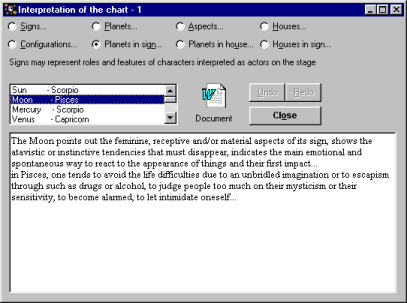
If Word 97 or higher is setup on your computer, you can use the Word document icon in order to open a Word document linked to StarLogin. If you double-click on the icon, you will open the default "NewWord.doc" file as it was previously saved (or empty if you never used it). If you want to use an other existing word document, the easiest way is to drag and drop it on the document icon and then double-click on the icon to open it.
Using copy, paste and other editing functions, you can use part of the content of the already existing interpretation data that are visible on the text box under the document icon.
You can modify the text in the text box. The database is automatically updated. And you can undo your modifications or redo them as long as you stay in the same text (That is e.g. if you are using the text for "Taurus", you must stay in this text. If you select the text for "Aquarius" or if you change the type of text and put the one for the "Mercury" planet, for example, you will no longer be able to undo the modifications in the "Taurus" text).
The tool gives you only the current values for the options "Planet in sign", "Planet in house" and "Sign in house". For example, if the sun of the chart is in Scorpio and in the house number five, the tool will only give you the "Sun – Scorpio", "Sun – House V", and "Scorpio – House V" available texts, but not "Sun – Pisces", "Sun – House I" or "Scorpio – House II"...
Sky charts established in non-local coordinates can represent the astrological houses using different systems. The following systems are usable for all locations on the terrestrial surface:
The following five house systems cannot be calculated in the Polar Regions (beyond polar circle):
The house systems simplest in their conception and most legitimate are probably those of Campanus, Maternus, and Porphyre.
Sky chart of an astrological or astronomical event can be established in seven distinct coordinate systems:
The primary directions of an astrological event are calculated from "Primary directions" submenu of "Forecasting" in the "Astrology" menu, or by clicking on the "Directions" button of the Tool bar and then on "Primary" in the appearing window, or even by pressing "Ctrl+F1" keys.
In the window where the primary direction chart will be calculated, keyboard the age (or the duration) that will be necessary to the calculation, before validating. This age is the number of years considered to be in progress after the date of the current event. It can be written under decimal form, that is in years and fractions of year.
Example: the primary directions of the natal chart of an individual when he is 36 years and 5 months old will be calculated by entering 36+5/12 = 36.416666666...
Use the Calculator if you want to calculate the wished decimal age precisely.
The primary directions represent the most complex predictive technique and the one that requires the maximum of chart hour precision. Indeed, because of the earth rotation angular velocity, the Ascendant position increases by one degree in only four minutes. And because of the planets revolution period around the Sun (in geocentric coordinates) or of apparent revolution around the Earth (in heliocentric coordinates), a little time may be sufficient -- less than two hours for the Moon -- to see these planets moving by one degree in the zodiac. Consequently, since this method puts the "1 degree = 1 year" equivalence, a 10 minutes error on the event chart date produces the following average errors on the primary directions:
This method is experimental and its reliability and foundations are not yet demonstrated.
The primary direction chart calculated from a given event reference chart (as the one of an individual birth - called the individual "horoscope") is above all interpreted in comparison with the reference chart.
The secondary directions of an astrological event are calculated from "Secondary directions" submenu of "Forecasting" in the "Astrology" menu, or by clicking on the "Directions" button of the Tool bar and then on "Secondary" in the appearing window, or even by pressing "Ctrl+F2" keys.
In the window where the secondary direction chart will be calculated, keyboard the age (or the duration) that will be necessary to the calculation, before validating. This age is the number of years considered in progress after the date of the current event.
The secondary directions, even if they are more frequently used and easier than the primary ones, seem to be without much foundation and not very predictive.
The secondary direction chart calculated from a given event reference chart (as the one of an individual birth - called the individual "horoscope") is above all interpreted in comparison with the reference chart.
The symbolic directions of an astrological event are calculated from "Symbolic directions" submenu of "Forecasting" in the "Astrology" menu, or by clicking on the "Directions" button of the Tool bar and then on "Symbolic" in the appearing window, or even by pressing "Ctrl+F3" keys.
In the window where the symbolic direction chart will be calculated, keyboard the age (or the duration) that will be necessary to the calculation, before validating. This age is the number of years considered in progress after the date of the current event.
The symbolic directions, even if they are more frequently used and easier than the primary ones, seem to be without much foundation and not very predictive.
The symbolic direction chart calculated from a given event reference chart (as the one of an individual birth - called the individual "horoscope") is above all interpreted in comparison with the reference chart.
The progressed Moon of an astrological event is calculated from "Progressed Moon" submenu of "Forecasting" in the "Astrology" menu.
The progressed Moon corresponds to the progression (or secondary direction) of the Moon since the date of the initial considered horoscope (generally the natal horoscope).
Starting with the initial Moon-Sun distance, we look at the day after the initial date when the first following exact moon phase takes place (for example when the last quarter occurs if in the initial chart the moon was between the full moon and the last quarter) and then, in turn, the day of each of the following phases.
Finally, using the ratio "One day = One year", we obtain the corresponding dates in the life of the individual. For example, if the first last quarter happened exactly three days and a half after the birth, an event corresponding to the symbolism of the last quarter might had happened when the individual was 3.5 years old.
The planetary revolutions or cyclic return of an astrological event are calculated from "Revolutions" submenu of "Forecasting" in the "Astrology" menu, or by clicking on the "Revolutions" button of the Tool bar and then on "Revolutions" in the appearing window, or even by pressing "Ctrl+R" keys. You can also use the wizard.
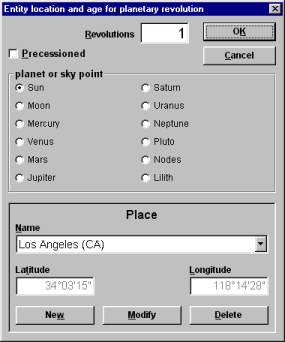
One or the other of these operations shows the window to select the planet or the sky point on which you wish to do the revolution. Select the wanted star, enter the number of returns to calculate, indicate the name and coordinates of the place where were (or where should be), at the time of the considered revolution, the entity concerned by the event, then validate.
Remark:
If the place is unknown, accept the proposed default place (New York, e.g.), or keyboard for example "NO" for the name and "0°00'00''" for each coordinate. In this case, the ascendant and the other houses cusps will remain without significance.
It can happen that some numbers or decimal numbers of returns are not calculable for certain stars or sky points, because of an inserted retrogradation that would forbid the calculations convergence. In that case, slightly modify the number and calculate again (in this case, the found revolution date will be of course not precisely the same as the one initially wished).
It is possible to keyboard a decimal number of revolutions to calculate the half, third, and quarters of revolutions notably.
Example: to calculate the sky chart corresponding to a Saturn revolution and a quarter after the event, enter 1.25 cycles, select Saturn, then validate.
The planetary revolution are used more frequently by astrologers than the directions, especially the solar revolution, and seem to give good enough predictive results, even though a scientific or esoteric foundation remains to be found.
A planetary revolution chart calculated from a given event reference chart (as the one of an individual birth -- called the individual "horoscope") is above all interpreted in comparison with the reference chart.
With tropical coordinates, a precessionned revolution gives the same date as a revolution calculated with sidereal ones.
The planetary cycles of an astrological event are calculated from "Cycles" submenu of "Forecasting" in the "Astrology" menu, or by clicking on the "Revolutions" button of the Tool bar and then on "real Cycles" in the appearing window, or even by pressing "Ctrl+Y" keys.
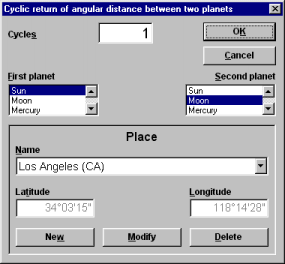
One or the other of these operations shows the window to select the couple of planets or sky points whose you wish to do a cycle. Select the two planets wanted, enter the number of cycles to calculate, indicate the name and coordinates of the place where were (or where should be), at the time of the considered cycle, the entity concerned by the event, then validate.
Remark:
If the place is unknown, let the proposed default place (New York) or keyboard for example "NO" for the name and "0°00'00''" for each coordinate In this case, the ascendant and the other houses cusps will remain without significance.
It can happen that some numbers or decimal numbers of cycles are not calculable for certain stars or sky points, because of an inserted retrogradation that would forbid the calculations convergence. Permute then the two stars or slightly modify the number of cycles and calculate again (in this case, the found cycle date will be of course not precisely the same as the one initially wished).
It is possible to keyboard a decimal number of cycles to calculate the half, third, and quarters of cycles notably.
Example: to calculate the sky chart corresponding to two cycles and quarter of Jupiter-Saturn after the event, enter 2.25 cycles, select Jupiter on the left and Saturn on the right, then validate. If the calculation is impossible because of non-convergence, select Saturn on the left and Jupiter on the right, then calculate again. If the calculation is always impossible, slightly modify the number of cycles...
The planetary cyclescycle are still used by astrologers. They have historically given good results since the advent of astrology and will perhaps find an esoteric theoretical foundation during upcoming decades, at least under the modified form that are the Symbolic planets cycles
A planetary cycle chart calculated from a given event reference chart (as the one of an individual birth - called the individual "horoscope") is above all interpreted in comparison with the reference chart.
The transits of an astrological event are calculated from "Transits" submenu of "Forecasting" one in the "Astrology" menu, or by clicking on the "Transits" button of the Tool bar, or even by pressing "Ctrl+T" keys.
In the window where will be calculated the transit chart, enter the transits date before validation.
The planetary transit on a charted planet or point represents, in the strict sense of the word, its conjunction (that is the same longitude or main coordinate) with the planet or point.
In the broad sense, astrology also considers the planetary transits in square, in trine or in opposition position, or even any other aspectaspect made with a chart planet or point.
Thus, one can, for example, observe the moments when Saturn crosses the individual radical Sun, or when it is in sextile, or in square... of Sun (or of any other chart planet or point)...
If some transits have a real influence on a person, the objective and detailed observation of all the planetary transits, in correspondence with the objective and subjective events of the person life, shows that all of them are bound to be significant. The real explanation of these facts is, for the time being, neither scientifically, nor astrologically found.
Nonetheless, there's no harm in suggesting a particular symbolic interpretation for the triple transit of a planet on a chart planet or point during its retrogradation (see Planets retrogradation)
During its retrogradation, a planet crosses a given chart point three times -- the first time with a direct motion, then a second one when it seemingly turns back, and finally a third one when it goes forward again.
Symbolically, one considers that during the first transit, the individual encounters a problem or a critical situation comparable to a closed door, according to the planet symbolism and to its position in comparison with the natal chart. During the second one, he finds the key enabling him to resolve the situation. Then during the third phase, he can free himself from the problem by opening the door and getting over it.
The transit chart calculated from a given event reference chart (as the one of an individual birth - called the individual "horoscope") for a particular date is above all interpreted in comparison with the reference chart.
The comparison of two astrological events is calculated from "Synastry" submenu of "Comparisons" in the "Astrology" menu or by clicking on the "Comparisons" button of the Tool bar and then on "Synastry" in the appearing window, or even by pressing "Ctrl+N" keys. You can also use the wizard.
In the window where the comparison chart will be calculated, validate to be able to define the event the sky chart of which should be compared to the one of the current event. In the event window, select the second event before to close.
Note: planets of the initial event are displayed on the outside circle of the comparison chart, and the second ones are on the interior circle.
The comparison or synastry of two sky charts, seems to be reliable enough to compare two events such as the birth of two individuals.
The comparison uses the same interpretation techniques as those of an individual chart (planets in signsigne and in housemaison, house in sign, and aspectsaspect...), except that one deals with the planets of the first chart in comparison with the houses or the signs of the second, and with aspects between the first chart planets and the second one planets...
The combination of several astrological events is calculated from "Composite" submenu of "Comparisons" in the "Astrology" menu or by clicking on the "Comparisons" button of the Tool bar and then on "Composite" in the appearing window, or even by pressing "Ctrl+M" keys. You can also use the wizard.
In the window where the combination chart will be calculated, enter the number of charts that will be combined before to validate, to be able to define the other events than the current one. In the event window, select the next event, then close. If the charts number is greater than 2, the event window is still shown as many times as necessary to select the next events.
The combination or composite of several sky charts seems to be a way of developing a synthetic idea of the event charts' interaction. Thus, this technique is particularly recommended to astrologically study a couple, a family, a small association or enterprise, or a small group of friends.
The combination chart is interpreted as an individual one, keeping in mind that one deals with separated entities.
The planets' barycenter of an astrological event chart is calculated by checking "Barycenter" in the chart window.
In the chart window, you can choose the calculation type:
Either Barycenter for planets having the same "weight" (or influence in the calculation).
Or Barycenter for planets having different weights. If you select this option, a dialog box appears in which you can put a weight value for each planet or sky point used in the astrological chart. The more important the value is for a given planet, the closer the barycenter will be to it.
The Barycenter that is defined here may be seen as a kind of balancing point of the horoscope.
The aspects of an astrological event chart are obtained from the "Grid" button (tab "Aspects" and option "Aspects type") after the chart has been calculated and drawn.
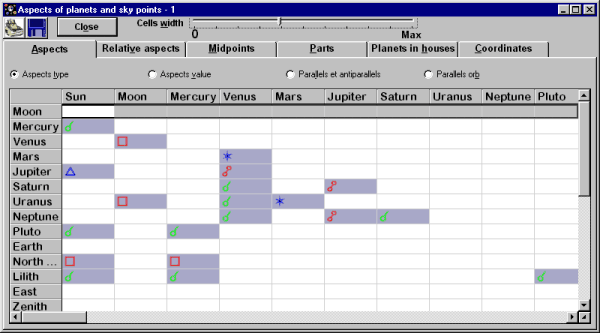
The real value of the aspects is given by the option "Aspects value" in the same tab.
The parallel and antiparallel aspects are given by the option "Parallels and antiparallels".
The orbs of parallel and antiparallel aspects are given by "Parallels orb"
The relative aspects of an astrological event chart are obtained from the "Grid" button (tab "Relative aspects") after the chart has been calculated and drawn.
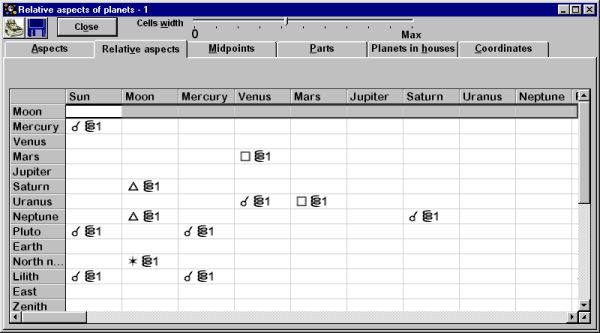
Relative aspect between 2 planets = angular distance between these planets x Sun-ascending distance / 180°.
The relative aspects are about the Awareness aspect of the individual (the awareness and the apprehension he has about things, about himself and about events; how he works on the awareness plane)...
The midpoints of an astrological event chart are obtained from the "Grid" button (tab "Midpoints") after the chart has been calculated and drawn.
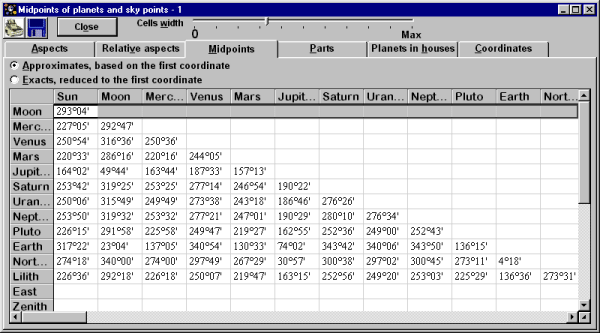
The midpoint between two planets is a virtual sky point in the averaged position of the two planets. One can see it as the result of these two planets energy combination. One then interprets it like a virtual planet that would have the resulting symbolism of this combination. At the present time, it is far from being proved that midpoints possess any reality at the astrological influence level.
The parts of an astrological event chart are obtained from the "Grid" button (tab "Parts") after the chart has been calculated and drawn.
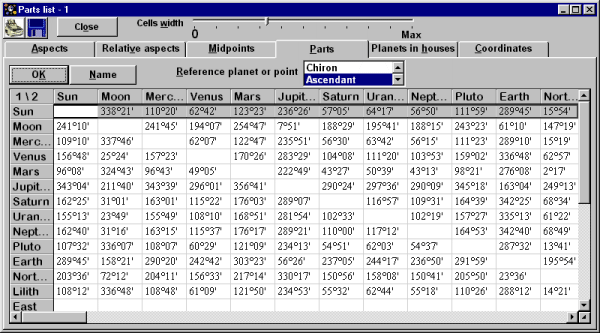
In the parts window, select the reference planet or the sky point and then validate to obtain the parts calculated with this reference.
Example: to obtain the parts with Ascendant as reference (that is Ascendant + planet1 - planet2 parts) such as the part of Fortune (equal to Ascendant + Moon - Sun), select the Ascendant as reference planet or sky point, then validate.
The parts name list can be obtain by clicking on the "Names" button in the parts window.
Note: parts are written with their coordinate calculated from Aries 0°. So, for example, a part having the value 137°39' would be at 17°39' of the Leo sign, because 120° (to obtain the Leo 0°: 30° for Aries + 30° for Taurus + 30° for Gemini + 30° for Cancer) + 17°39' = 137°39'.
A partpart is a virtual sky point calculated from the position of three planets or sky points, according to the formula:
Part = Reference planet position + planet 1 position - planet 2 position.
If at least some parts including the one of fortune can have some real influence, it seems that one doesn't know the real reason for that.
Planets retrogradation and other astrological elements
Several astrological elements for the current chart can be found by clicking on the "Grid" button of the chart window and then on the "Coordinates" tab:
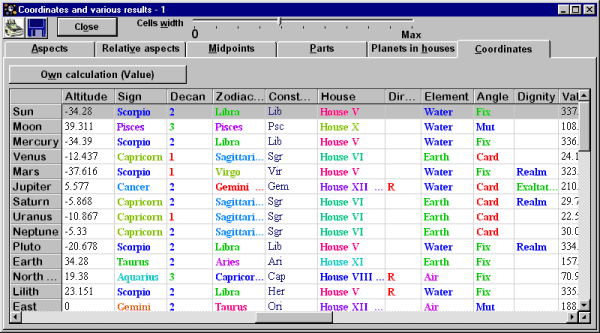
Planetary Retrogradation Cycles
During their apparent revolution around the Earth, the planets that actually orbit the Sun periodically appear to reverse their direction of travel and move backward. This phenomenon occurs as the Earth, turning around in its yearly orbital path around the Sun, reverses her direction of travel and appears to overtake and pass another planetary orbital.
In a chart, the retrograde planets are inticated with a "R" after or before the symbol of the planet. In addition, the stationnary planets are indicated with a "S" in the "Grid" result for "Coordinates", in the "Directions" column.
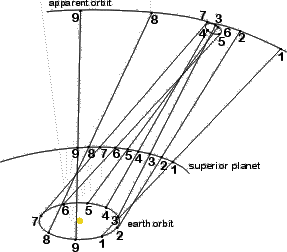 (apparent
movement of an external planet)
(apparent
movement of an external planet)
In a chart with geocentric coordinates, the chance of having retrograding planets (among Mercury, Venus, Mars, Jupiter, Saturn, Uranus, Neptune and Pluto) is given below:
Therefore, sky charts having only two retrograding planets are the more frequent, and those having eight are the rare (since one must establish 20,000 charts, on average, to have a chance of seeing one of them with all retrograding planets)!
One must note that the Moon being not a planet but a natural satellite of the Earth, and directly turning around her but not around the Sun, is not affected by the retrogradation phenomenon.
In addition to the retrogradation indication, you can also find the following elements, for each planet:
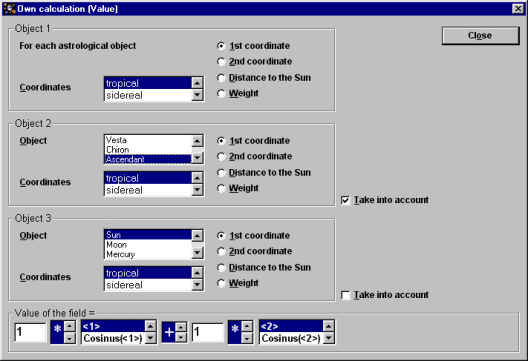
The default formula, shown in the above window is:
First coordinate of the planet in the tropical system (that is the "geocentric longitude") + First coordinate of the Ascendant in the same system. So, if the Sun is for example at 20° in Virgo (20°+5*30° = 170°) and the Ascendant is at 12° in Aquarius (12°+10*30° = 312°), the own value for the Sun is 2° in Leo (170° + 312° - 360° = 122° and 122° = 4*30° + 2°).
Find the event date and place of a tropical chart
When you don't know the references of an event for which you possess an astrological chart in tropical coordinates, (for example, where the author of the book or the article in which you found this chart didn't mention them,) you can attempt to recover them by clicking on the "Date and place of a chart" submenu of "Calculate" in the "Astrology" menu, or by pressing "Ctrl+D" keys.
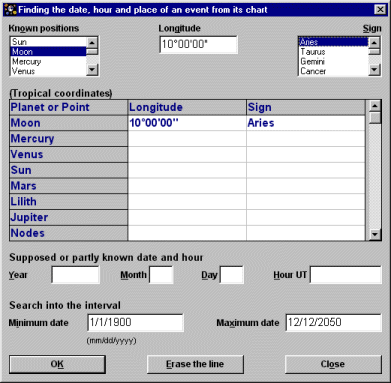
When you only know the partial references of an astrological event, as the birth of an individual for whom you only know the date or the year, but not the place nor the hour for example, if you know at least the position of his sign (the position of the Sun), or of a fast planet as the Moon or Venus, and of an another one of his planets (if possible a slow planet as Saturn), you can attempt to recover them in the same way.
Remark: one century starts in the year 1 of the century, and not in the year 0! Thus, the twenty-first century will begin on January 1, 2001 at 0 o'clock in the morning, not on January 1, 2000!